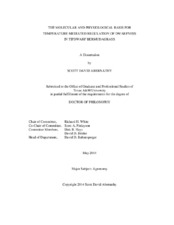| dc.description.abstract | Tifdwarf (C. dactylon (L.) Pers. x C. transvaalensis (Burtt-Davies) has been used on putting greens in the southern US for over 50 years. Dwarfism in Tifdwarf (TD) bermudagrass is a conditional trait. Tifdwarf internodes and leaves elongate when exposed to suboptimal temperatures. This study further quantified physiological aspects of this response and investigated the role of gibberellins in the temperature mediated release of TD dwarfism.
In controlled environment studies, TD internode and leaf lengths were two times longer in suboptimal (27°C/19°C day/night) compared to optimal temperatures (35/27°C). In NuMex Sahara (NM), a non-dwarf bermudagrass, internode and leaf length decreased or showed no response to suboptimal temperatures.
When grown under suboptimal temperatures, TD accumulated the same or less biomass than optimal treatments. NM accumulated less biomass. Suboptimal temperature reduced respiration in TD but had no affect on photosynthesis.
To investigate the role of gibberellins in conditional dwarfism, expression patterns for GA20ox1, GA20ox2, GA3ox, GA2oxa, GA2oxb and GAMyb were analyzed. Under optimal temperatures, GA20ox2 and GA3ox expression were higher and GA2oxa expression was lower in TD than NM. Similar expression patterns are common in many GA associated dwarf mutants.
Despite limited phenotypic differences in NM given different temperature treatments, GA20ox2 and GA3ox were elevated and GA2oxa and GAMyb were depressed in suboptimal treatments. Unlike NM, and despite robust phenotypic changes, TD displayed minimal molecular responses to suboptimal temperatures. Only GA2oxa and GA2oxb displayed differential expression patterns between treatments. Both were higher in the suboptimal temperature regime.
The GA biosynthetic inhibitors CCC and flurprimidol decreased TD internode length while GA3 increased length under both temperature treatments, however internodes from suboptimal treatments remained longer than optimal treatments. Trinexapac-ethyl also decreased internode length in both temperature treatments, but at the high application rate, no difference was measured between temperature treatments. Therefore, functional late-stage GA metabolic and/or catabolic enzymes are required for temperature mediated adjustments in TD morphology.
No difference due to temperature was observed in bermudagrass internode length when an inhibitor combination plus GA3 was applied. This suggests that the temperature mediated adjustments in morphology are not the result of altered GA sensitivity. | en |


